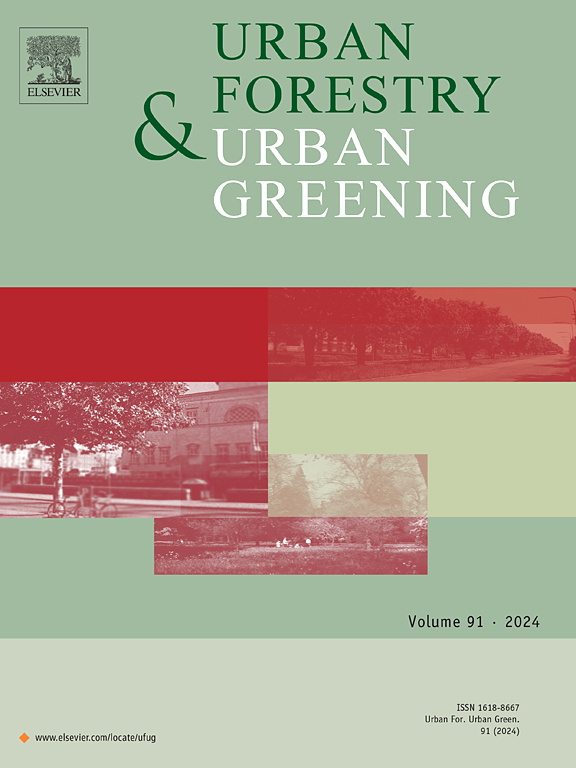Advancing urban shade mapping for planning: Integrating shade demand and greening potential
IF 6
2区 环境科学与生态学
Q1 ENVIRONMENTAL STUDIES
引用次数: 0
Abstract
Shade is an effective measure for reducing outdoor heat exposure. More infrastructure is needed to protect urban populations from direct sunlight during outdoor travels in hot weather, but shade is often overlooked in planning. This research uses the metropolitan area of Nanjing, China, as a case study to explore the spatiotemporal dynamics of population movement and shade, utilizing data from mobile phones and airborne LiDAR. The results reveal a dynamic spatial correlation between shade coverage and outdoor population density: positive in the morning and late afternoon and negative at midday, which indicates a spatial mismatch during high solar elevation angles. This study assesses the potential for developing green spaces to provide shade infrastructure, recognizing the community as the fundamental planning unit for human activities. We found that only 17 % of communities in Nanjing possess a high potential for greening. The greening potential of most communities does not meet their shade demand. We introduce the concept of shade-optimized zoning and develop shade infrastructure optimization strategies based on the “necessity-feasibility” framework. This urban shade planning analysis framework includes shade mapping, shade infrastructure demand classification, an assessment of shade potential, shade optimization zoning, and a solution proposal to promote climate-resilient cities.
推进城市荫蔽制图用于规划:整合荫蔽需求和绿化潜力
遮阳是减少室外热暴露的有效措施。需要更多的基础设施来保护城市人口在炎热天气下户外旅行时免受阳光直射,但在规划中往往忽视了阴影。本研究以南京都市区为例,利用移动电话和机载激光雷达数据,探讨人口移动和阴影的时空动态。结果表明,遮阳覆盖度与室外人口密度呈动态空间相关性,在上午和下午晚些时候呈正相关,中午呈负相关,表明在高太阳仰角时存在空间失配。本研究评估了开发绿色空间以提供遮阳基础设施的潜力,认识到社区是人类活动的基本规划单元。我们发现南京只有17 %的社区具有很高的绿化潜力。大多数社区的绿化潜力不能满足其遮荫需求。我们引入了遮荫优化分区的概念,并基于“必要性-可行性”框架制定了遮荫基础设施优化策略。该城市荫蔽规划分析框架包括荫蔽制图、荫蔽基础设施需求分类、荫蔽潜力评估、荫蔽优化分区以及促进气候适应型城市的解决方案建议。
本文章由计算机程序翻译,如有差异,请以英文原文为准。
求助全文
约1分钟内获得全文
求助全文
来源期刊

Urban Forestry & Urban Greening
FORESTRY-
CiteScore
11.70
自引率
12.50%
发文量
289
审稿时长
70 days
期刊介绍:
Urban Forestry and Urban Greening is a refereed, international journal aimed at presenting high-quality research with urban and peri-urban woody and non-woody vegetation and its use, planning, design, establishment and management as its main topics. Urban Forestry and Urban Greening concentrates on all tree-dominated (as joint together in the urban forest) as well as other green resources in and around urban areas, such as woodlands, public and private urban parks and gardens, urban nature areas, street tree and square plantations, botanical gardens and cemeteries.
The journal welcomes basic and applied research papers, as well as review papers and short communications. Contributions should focus on one or more of the following aspects:
-Form and functions of urban forests and other vegetation, including aspects of urban ecology.
-Policy-making, planning and design related to urban forests and other vegetation.
-Selection and establishment of tree resources and other vegetation for urban environments.
-Management of urban forests and other vegetation.
Original contributions of a high academic standard are invited from a wide range of disciplines and fields, including forestry, biology, horticulture, arboriculture, landscape ecology, pathology, soil science, hydrology, landscape architecture, landscape planning, urban planning and design, economics, sociology, environmental psychology, public health, and education.
 求助内容:
求助内容: 应助结果提醒方式:
应助结果提醒方式:


